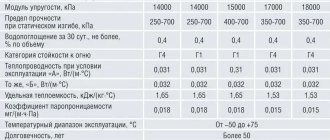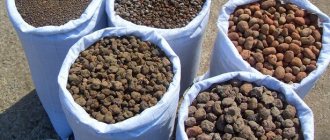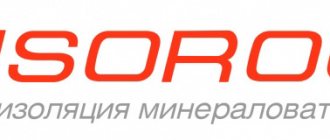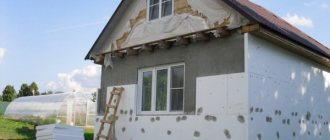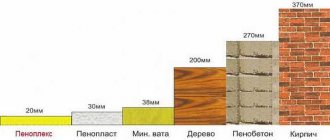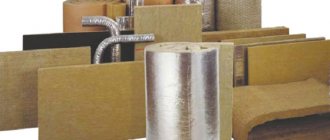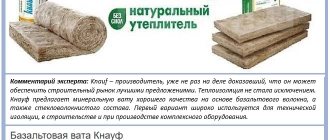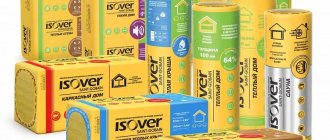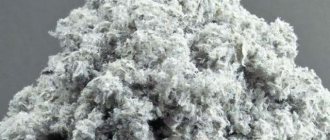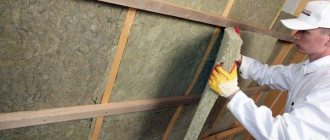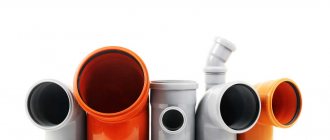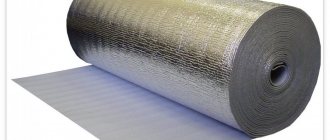Review of hygroscopicity of thermal insulation
High hygroscopicity is a disadvantage that needs to be eliminated.
Hygroscopicity is the ability of a material to absorb moisture, measured as a percentage of its own weight of insulation. Hygroscopicity can be called the weak side of thermal insulation and the higher this value, the more serious measures will be required to neutralize it. The fact is that water, getting into the structure of the material, reduces the effectiveness of the insulation. Comparison of hygroscopicity of the most common thermal insulation materials in civil engineering:
| Name of material | Moisture absorption,% by weight |
| Minvata | 1,5 |
| Styrofoam | 3 |
| PPU | 2 |
| Penoizol | 18 |
| Ecowool | 1 |
A comparison of the hygroscopicity of home insulation showed the high moisture absorption of foam insulation, while this thermal insulation has the ability to distribute and remove moisture. Thanks to this, even when wet by 30%, the thermal conductivity coefficient does not decrease. Despite the fact that mineral wool has a low percentage of moisture absorption, it especially needs protection. Having absorbed the water, it holds it, preventing it from leaving. At the same time, the ability to prevent heat loss is catastrophically reduced.
To prevent moisture from entering the mineral wool, vapor barrier films and diffusion membranes are used. Basically, polymers are resistant to prolonged exposure to moisture, with the exception of ordinary polystyrene foam, which quickly deteriorates
In any case, water does not benefit any thermal insulation material, so it is extremely important to exclude or minimize their contact
Electric boiler
Unlike a gas system, an electric boiler is compact and easy to operate. There are different models of electric boilers. The power of the unit is selected depending on the area of the room. Electricity heats the air, then a pump pumps it throughout the heating system. Heated air constantly circulates in a confined space, heating the house.
If you place the boiler in the basement, it does not take up space in the house, but this is fraught with large heat losses. A lot of heat will be spent heating the basement. When planning a house, it is better to allocate a separate room for the boiler, adjacent to the residential sector. Thus, you will ensure high heat transfer with minimal heat loss and save electricity.
Electric boilers operate silently, do not emit any odor, and are easy to install and operate. The specifics of their connection should be taken into account. For example, if your boiler is low-power (3.5-7 kW), it needs to be allocated a separate branch from the distribution panel and installed automatic protection. A powerful unit (from 7 kW and more) is connected only to a three-phase network.
The only disadvantage of an electric heating system is its high price, but people often use it because of its convenience and ease of installation.
Statistics
Many people believe that it is enough to buy insulation and install it on the wall and it will function normally. You need to select the right material and, most importantly, it should be enough. The thickness of different insulation materials varies greatly, so you need to familiarize yourself in advance with the thermal conductivity of which material you will be working with.
Not everyone will want to shell out large sums of money for insulation for a wall made of aerated concrete, which suddenly won’t work. Much depends on the thickness of the wall and the insulation itself; 10 cm will be enough for the use of wool to be correct. Which cotton wool is best for insulation? To begin with, it is worth comparing the characteristics of different types of thermal insulation.
Additional properties of thermal insulation materials:
Density. The ratio of mass to volume occupied by a material.
Moisture absorption. Determines the amount of moisture contained in the insulator
It is important to consider the total moisture content of the material at various temperature changes, relative to the importance in the air. Hydrophobization significantly reduces the properties of mineral wool to absorb moisture
For this purpose, special additives are specially introduced that protect the material from water.
Biosecurity. The ability to counteract the dominance of microorganisms, as well as the development of fungal formations and some types of insects. For the most part, all living creatures are attracted to dampness, so the moisture-protective properties closely interact with thermal insulation.
Fire resistance. Structures can withstand high temperatures for a long period without collapsing.
Fire safety.
Strength. If the strength is high, then the material is used to insulate load-bearing fencing structures. There is also a separate parameter - bending strength. This applies to those insulation materials that are installed on pipelines and other similar objects. Tensile strength is necessary in order to determine the possible level of safety during storage, transportation and installation.
Endurance. A material can lose all its properties and features when the temperature increases or decreases.
Heat capacity. In conditions of frequent thermal changes, this characteristic is extremely important.
Frost resistance. The ability of the material to withstand repeated temperature changes at any stage of freezing. Relevant in winter with severe frosts. The main thing is that no visible signs of destruction of the insulation structure are noticed.
Insulation for the walls of a house is not the only function that can be limited. The home owner should give preference to external insulation, as well as thermal insulation of pipelines.
from different sides of the house with equal efficiency.
Thermal insulation properties can be leveled due to a number of mistakes. For example, inappropriate fasteners. When insulating with foam plastic, dowels and cheap, low-quality glue are used.
If you have forgotten the parameters of moisture resistance, density or other insulation characteristics, then it is worth looking at the ratings of various thermal insulators. The table will help you quickly navigate and find the best material based on one of its properties.
The basement deserves just as much attention as the rest of the house.
It takes an important part in the heat losses of the building, its role is key. Especially when it comes to facade insulation
This instructional text will help home owners who decide to install thermal insulation themselves, without the help of specialists. Let's start with filling, the technology of which turned out to be unsophisticated and simple.
- We drill holes on the outside wall in a staggered pattern.
- We stretch the tubes from the special installation and insert them into these holes.
- After this, we supply the foam material.
The whole process happens so quickly. That two people are enough to insulate three floors of a cottage. Insulating the outside with slabs will be much more expensive than the above insulation option. The price of many companies increases with each centimeter of cavity width.
Foamed polyethylene Penofol
This thin reflective insulator has amazing properties and is confidently conquering the construction market. Penofol is made from foamed self-extinguishing polyethylene. The structure is closed-cell. The outer covering is aluminum foil.
There are five types of penofol:
- With one-sided foil - type A, cheap in price. Can only be used for interior work.
- With double-sided foil. Can be used for various needs, including on balconies, loggias, and under the roof.
- With one-sided foil and a self-adhesive layer on the second side - penofol 2000-C. This makes installation much easier and cheaper.
- Penofol Classic - one-sided foil, thickness 3-10 mm, the cheapest in price.
- Armofol is a penofol with double-sided foil, reinforced with a polymer mesh and a latex layer.
Armofol has even more unique qualities than regular penofol:
- The small thickness allows you to achieve the same heat-saving effect as 10 cm foam plastic.
- The material is flexible, which allows for seamless sealing of corners and joints.
- Thanks to its closed structure, penofol simultaneously serves as a hydro- and vapor barrier (saving).
- Installation is as simple as possible - using glue or dowels with wide caps.
- The insulating layer does not take up room space; it can be used under any type of warm floor.
- The thermal reflection coefficient of the penofol surface is 96-97%. This is the highest figure among all insulation materials.
Armofol has such heat-retaining properties that you can sleep on the ground on the mat - it is used to make mats and blankets for extreme cases (you should have one in your car and on a hike). The manufacturer recommends using Armofol in complex buildings - baths, saunas, swimming pools, unheated cottages (they will not freeze in winter), in poultry houses, as well as for insulating roofs of any complex configuration.
Table 6. Main technical characteristics of foamed polyethylene.
| Parameter | Meaning |
| Thickness, mm | 3-40 |
| Weight, density kg/cub.m | 40 |
| Thermal conductivity - coefficient W/m k | 0,03-0,05 |
| Durability, year | 30 |
| Vapor permeability, mg/(m h Pa) | 0,001 |
| Environmental friendliness, group | 1 |
| Compressive strength coefficient, MPa | 0,03-0,2 |
| Water absorption in 24 hours,% | 0,35-0,7 |
| Flammability, group | G1 |
| Possibility of finishing, class | 1 |
The price of penofol insulation directly depends on the type of material and its thickness. With a thickness of 4 mm, the price of finishing 100 m2 will be about 5 thousand rubles, if the thickness is 10 mm - up to 8 thousand, and with 4 cm - about 50 thousand.
There is an opinion that differs from the assurances of the manufacturers. Many construction experts argue that for our climatic conditions the thinnest foam foam is not enough - you need to take either the thickest sheet possible or lay it in several layers. And this significantly increases the price of all insulation.
Main types of thermal insulation
Thermal insulating materials for installing electric heated floors are made from natural and synthetic raw materials. From a large assortment, we can highlight the thermal insulation materials presented below.
Might be interesting
Natural thermal insulation is made using a special technology from cork oak bark and is therefore called cork. Such insulation is supplied to the retail chain in the form of rolls 10 m long and 1 m wide. Thickness ranges from 1 to 10 mm. During installation there is no need to glue it, it is easy to install, has excellent sound and heat insulation properties, and can have a rubberized base, which eliminates the need for additional waterproofing.
Cork thermal insulation
Modern thermal insulation materials of artificial origin for electric floors include the following products:
"Penotherm". It is made of porous polypropylene, has a cellular structure, without and with markings. The latter makes the installation process easier. Aluminum foil serves as a heat-reflecting layer. Depending on the quality of installation, it can increase thermal efficiency by up to 70%. The insulation is supplied to the retail chain with a width of 1200 mm and a length of 10 and 30 m, of various thicknesses.
Insulation "Penotherm"
"Penofol". Made from foamed polyethylene. It has a foil layer with a thickness of 100 microns. Available in four types, differing in surfaces. "Penofol" type A has a foil surface on one side, type B has a foil surface on both sides, type C has one side with foil and the other has an adhesive layer, type ALP also has a foil side and is located on the other polyethylene film. Rolls have a thickness of 3÷10 mm and a length of 10÷30.
Thermal insulation material "Penofol"
"Folgoizolon". It is made of foamed polyethylene and has air bubbles in its design, as well as a foil layer. Available in two modifications: cross-linked (PPE) and non-cross-linked (NPE) polyethylene foam, differing in service life. For products made from cross-linked polyethylene it is much higher. Thanks to the material with high technical characteristics, it retains heat well. Supplied with or without underfloor heating markings in sheets rolled into rolls of various thicknesses and lengths. It is an ideal heat-insulating material for installing heated floors on balconies, loggias and other cold rooms.
Material "Folgoizolon"
Additional insulation can be a polyethylene laminated film with markings for underfloor heating. Products with a thickness of 3 or 5 mm, a width of 1 m and a length of 10 to 30 m are used.
Insulation film
Insulation materials
126 votes
+
Vote for!
—
Vote against!
Have you decided to make your home energy efficient in order to spend less money on heating it, or simply insulate the walls to make living in it more comfortable, but you don’t know what material to choose? After all, you want it to be of high quality, not let water through, not make the structure too heavy, be vapor-permeable, not afraid of fungus and mold, and at the same time, preferably not too expensive, not have a negative impact on human life, and better yet, be natural. Thermal insulation materials presented on the modern market amaze with their diversity, among which it is not easy to make the right choice. In this article, we will determine what characteristics you should pay attention to, what advantages and disadvantages certain types of materials have and what they are made of.
Content
- Characteristics of thermal insulation materials
- Thermal insulation materials for walls
- Thermal insulation materials from inorganic raw materials
- Polymer thermal insulation
- Thermal insulation materials from organic raw materials
- Comparison of thermal insulation materials
First, let's find out why such materials are needed and what they are.
The main function of thermal insulation material is to prevent heat loss from the insulated room, for example, in the cold season, and heat penetration inside, in hot summer. Heat transfer is due to the movement of molecules, which cannot be stopped completely, but can be reduced. So, in still, dry air, molecules move slowest. It is this property that was taken as the basis for the production of heat-insulating materials, which are air packaged in various ways: in pores, cells, capsules.
Characteristics of thermal insulation materials
When choosing a particular insulating material, you should pay attention to several fundamental characteristics.
Thermal conductivity coefficient (lambda - λ) is the main indicator for thermal insulation materials. It shows the amount of heat that passes through a material having a thickness of 1 m and an area of 1 m2 in one hour, provided that the temperature difference on opposite surfaces is 10 ° C. For example, the thermal conductivity coefficient of dry air is 0.023 W/(m*C). The value of thermal conductivity is influenced by other characteristics of the material: porosity, humidity, temperature, chemical composition and others.
Porosity is the percentage of air pores in the total volume of the product. Can be 50% or more. In some cellular plastics it reaches 90 - 98%. Pores can be open, closed, small or large. Their uniform distribution within the material is very important.
Humidity – the amount of moisture contained in a material. This parameter affects thermal conductivity. Since water conducts heat very well, a material saturated with water - wet - will not perform its functions.
Water absorption is the ability of a material to absorb water in direct contact with it. A very important point for external insulation, which may be under precipitation, for internal insulation in rooms with high humidity levels. If the material absorbs water, its properties will decrease.
Vapor permeability is the amount of water vapor passing through a material 1 m thick and 1 m2 in area in 1 hour, provided that the temperature is the same on both sides of the material and the difference in partial vapor pressure is 1 Pa. This parameter affects the need to install additional vapor barrier.
The density of a material affects its mass. Using it, you can calculate how heavy the structure will be if you use this or that material of a certain thickness.
Biostability determines whether the development of fungi, mold and other pathogenic flora on the surface or inside the structure of the material is possible.
The heat capacity of the material is important in regions with frequent temperature changes. It shows the amount of heat that the insulation can accumulate.
There are other characteristics: fire resistance, strength, frost resistance, bending strength and fire safety indicators. When choosing a material, you should also pay attention to them, as well as to another indicator that is not directly related to a specific thermal insulation material:
Coefficient U is the ability of a structure to transmit heat. Whether walls, ceilings or floors, depending on the materials from which they are made, they can transmit heat in different amounts and at different rates. This coefficient is a combined value, the calculation of which includes all materials used in layers and the air gaps between them. The U-value of a particular building or structure will determine what thermal insulation material can be used and what thickness of this material is required.
Thermal insulation materials for walls
Today, the production of thermal insulation materials has been established, both from inorganic and organic raw materials. Let us consider them separately due to their different effects on the environment and humans, as well as the conditions of disposal.
Thermal insulation materials from inorganic raw materials
Mineral wool is perhaps the most common material at the moment. Produced from mineral raw materials: dolomites, basalts and other minerals. The fibers obtained as a result of melting minerals are held together with a binder, which is often phenol-formaldehyde resin. The ease of production determined the low price of this material.
Advantages of mineral wool:
- Good thermal insulation properties.
- Practically does not absorb moisture.
- Frost-resistant.
- Can serve as additional sound insulation.
- Does not burn.
- Durable.
- Does not change its characteristics.
- Not subject to rotting.
- "Breathing."
Flaws:
- Not strong enough.
- Requires vapor barrier.
- Requires waterproofing.
- Phenol formaldehyde is a toxic substance.
- Requires special disposal.
Release form: loose wool, mats, cylinders, slabs with different densities (light, soft, semi-rigid, hard).
Stone wool is made from diabase rock by melting and turning the liquid mass into fibers. This material consists of 99% air and only 1% rock. It is used for insulation of walls and other structures everywhere.
Advantages of stone wool:
- Provides sound insulation.
- Does not burn.
- Not subject to rotting.
- Prevents the spread of fire. Melts at a temperature of 1000 °C.
Flaws:
- Energy-intensive production process.
- Requires special disposal.
Foam glass (cellular glass) is made from glass powder by sintering it with gas-forming agents. Air occupies 80–95% of the material.
Advantages of foam glass:
- Durable. You can drive nails.
- Water resistant.
- Frost-resistant.
- Does not burn.
- Not subject to rotting.
- Durable.
Flaws:
- Does not “breathe” (additional ventilation is required).
- Dear.
Perlite is a volcanic rock. When heated, it increases several times, which is why the production process resembles the creation of popcorn. Used for thermal insulation since the middle of the last century.
Advantages of perlite:
- Environmentally friendly material.
- Does not burn.
- Does not absorb moisture.
- Doesn't settle.
- Resistant to rotting and the influence of pathogenic flora
- Easy to use (can be poured or blown into voids).
- Can be disposed of by composting (improves soil quality).
Flaws:
- It can spill out of voids when laying pipes or cables in the walls.
Thermal insulating materials made from inorganic raw materials also include various thermal insulating concretes: aerated concrete, cellular concrete, foam concrete. As well as concrete with aggregates: expanded clay concrete, perlite concrete, polystyrene concrete.
Polymer thermal insulation
Extruded polystyrene foam has a solid, durable microstructure. The cells are closed, impenetrable and filled with air. Neither water nor air can penetrate from cell to cell.
Advantages of extruded polystyrene foam:
- Good thermal conductivity.
- Inert towards most substances.
- Does not absorb moisture.
- Stronger than foam.
Flaws:
- Flammable (releases toxic substances during combustion).
- Doesn't "breathe".
Polystyrene foams are small balls held together. They can be produced using both press and non-press methods.
Advantages of polystyrene foams:
- Inexpensive.
- Durable.
- Well insulated.
- Easy to install.
Flaws:
- When exposed to sunlight, they turn yellow and disintegrate.
- They don't "breathe".
- They are burning.
- When moisture penetrates, the structure is destroyed.
Polyurethane foam is a liquid heat-insulating material. When the ingredients are mixed with air, a fine aerosol is formed, which can be sprayed onto a surface of any geometry.
Advantages of polyurethane foam:
- Amazing elasticity of the material.
- Resistant to fungi and mold.
- You can insulate uneven surfaces.
- Easy installation that does not take much time.
- Has no joints.
Flaws:
- It burns, releasing toxic substances.
- Doesn't "breathe".
- Special installation is required for installation.
Thermal insulation materials from organic raw materials
Paper has been used for insulation since the middle of the last century. Such materials are granules obtained from newspapers and other waste paper. To blow these granules into the voids in the walls, the help of specialists is required.
Advantages of paper-based thermal insulation materials:
- Do not burn (treated with neutral salts).
- Repel water.
- Fills cavities well.
- Easy to use.
- Do not harm the environment.
- Can be disposed of by normal composting.
- Resistant to fungi.
- Do not require additional vapor barrier.
Flaws:
- Limited scope of application due to the specific shape of the product - granules.
Linen is used as insulation quite rarely, mainly by those who care about the environment and their health. The reason for the limited distribution of flax materials is the high price. Although it is predicted to decrease over time.
Advantages of linen insulation:
- Excellent insulating properties.
- Do not require additional vapor barrier.
- Dispose of by burning or composting.
- Absolutely natural.
- Resistant to fungi and microorganisms.
Flaws:
- Difficult to cut.
- Additional fire protection is required.
Wood fiber (cellulose wadding) is currently considered one of the most famous organic thermal insulation materials. It is a wood material ground into cotton wool. It is produced both in bulk form and in slabs. Used for blowing into wall cavities.
Advantages of cellulose wool:
- Increased thermal insulation properties.
- Serves as sound insulation.
- Simple and easy to use.
- Compostable.
Flaws:
- Susceptible to rot and fungus.
- Cannot be used to insulate hollow walls of old buildings.
- Ammonium polyphosphate is added to improve fire-resistant qualities.
Cork insulation is made from the bark of the cork oak tree without the use of synthetic substances. Cork is another completely natural insulation material, just like flax.
Benefits of cork:
- Doesn't rot.
- Does not shrink.
- Resistant to compression and bending.
- Easy.
- Durable.
- Inert to most substances.
- Doesn't burn (but smolders).
- During smoldering it does not emit harmful substances.
Flaws:
- Treated with anti-flammable impregnations.
Comparison of thermal insulation materials
Before choosing a material for insulation, it is advisable to consult with specialists. Based on the material of the walls, their thickness and operating conditions (climate), they will advise which materials may be suitable in a particular case and what their thickness should be. If you do not hear the material you would like to use in the list of proposed options, please clarify this nuance. Perhaps this material simply fell out of the specialist’s attention, or maybe it is categorically not suitable for this design.
It is impossible to single out the best thermal insulation material. All of them are good to one degree or another for specific purposes. The choice depends primarily on the thermal insulation properties and on personal preferences and financial capabilities.
For example, when building a completely eco-friendly house made of wood, it would be absurd to use polystyrene foam or polystyrene foam for insulation. It makes sense to pay attention to natural materials: linen, paper, cellulose and cork.
In the construction of modern multi-storey buildings, foam plastic and other polymer materials are widely used, since their price is low, they are easy to install and have good thermal conductivity. But basically no one thinks about the impact of such materials on human life. It is enough for developers that the manufacturer has assured that the product is safe.
In the presented table of the use of thermal insulation materials:
The correct choice is indicated in gray;
Options that should be implemented taking into account fire safety are indicated in yellow;
Red color - cannot be used.
As can be seen from the table, any of the materials presented in the article is good in its place: some are better used for insulating walls, others - floors, and others - attics and roofs. Even for thermal insulation inside or outside a building, different materials are suitable.
Types of materials for external wall insulation
Most often, houses are insulated on the outside with the following types of materials:
- Foam plastic – has a low thermal conductivity. It consists of 90% air and 10% polymers. Easy to install and quite cheap.
- Mineral wool is a heat-insulating material made from metallurgical slag and silicates. Unlike glass wool, working with it is safe.
- Polyurethane foam - does not require the construction of frame structures. All work is carried out only by professionals, since working with insulation requires certain skills.
- Penoplex is a new formula for wall insulation that retains heat better and more efficiently. It has a finely porous structure due to extrusion. Has high thermal insulation characteristics.
They also use thermal insulation, expanded polystyrene, liquid expanded clay materials, cellulose, etc. However, these insulation materials are not used as often as the above. Therefore, we will focus on considering the main insulation materials for walls.
Mineral wool
Mineral (basalt, stone) wool is a fibrous insulation material that is similar to the natural material basalt. This insulation is made from alloys of volcanic rocks at very high temperatures. This type of wool is completely fireproof and unaffected by fire.
Mineral wool options
Mineral wool is an absolutely environmentally friendly wall insulation material that poses no danger to people or the environment. Installation of mineral wool on the facade and walls takes place in several stages:
- Preparing the outside walls of the house.
- Laying a layer of vapor-permeable membrane over the wall.
- Fastening wooden slats or profiles to walls.
- Laying heat-insulating mats.
- Another layer of film is stretched over the insulation.
- Installation of a ventilating facade of the house from the outside.
And at the final stage, new slopes, window sills and finishing elements are installed due to the increase in the thickness of the walls.
Styrofoam
Polystyrene foam is very often used to insulate external walls. After all, its thermal conductivity is lower than that of mineral wool - 0.032-0.038 W/m*K and is slightly inferior to extruded polystyrene foam.
Styrofoam
Installation of foam plastic on the walls of the house is as follows:
Installation diagram of foam insulation
- Facade preparation.
- Setting up a starting profile.
- Applying adhesive composition to insulation.
- Gluing foam plastic boards to the walls of the house.
- Fastening sheets using dowel fasteners.
- Installation of reinforcement elements.
- Subsequent reinforcement.
- Applying a decorative protective layer to the wall.
- Giving the façade texture.
Drawing of mounted foam
Polyurethane foam
This material for insulating the outside walls of a house is one of the types of plastic. It has a cellular foamy structure and is 90% gaseous. The remaining volume is the cell walls.
Polyurethane foam in section
Insulation of the walls of a house using this thermal insulation material takes place in the following order:
Polyurethane foam insulation scheme
- Preparing the walls.
- Application of insulation.
- Reinforcement to improve thermal insulation.
- Finishing work.
Penoplex
Extruded penoplex is an innovative development that is designed to save energy resources.
Penoplex
Today, more and more home owners prefer Penolex due to its high performance characteristics. How does the insulation installation process go:
Penoplex insulation scheme
- Preparatory work on the walls.
- Installation of profiles.
- Applying glue to insulation boards.
- Penoplex gluing.
- Fastening with dowels.
- Finishing outside.
Variety of materials
Before purchasing, you need to consider the main types of insulation and their characteristics to select the best option. This will allow us to evaluate the possibility of using the material to form an insulating pie on a particular surface.
Arbolite and expanded clay
Natural insulation materials include wood concrete and expanded clay. Wood concrete is obtained by introducing small sawdust or chopped straw, as well as a number of additives, into the cement mortar. It is produced in the form of slabs and bulk material. At the last stage of production, the material is processed with a mineralizer. Its density ranges from 500 to 700 kg/m³. The thermal conductivity coefficient is 0.08-0.12 W/mK. Strength is 0.5-3.5 MPa.
Expanded clay is a bulk material that is made by swelling and further firing clay. Thermal conductivity is 0.07-0.16 W/mK. The strength of the material is 0.6-5.5 MPa. The water absorption coefficient does not exceed 8-20%. When combined with a cement mixture, this material gives a good soundproofing effect.
Stone wool, glass wool and ecowool
Varieties of construction wool are most often used to provide thermal insulation. The characteristics of this type of insulation may vary depending on the characteristics of production. Mineral or stone wool is made from dolomite, diabase, limestone, basalt and other rocks. Phenol or urea is used as a base. This material does not burn, does not shrink and does not absorb water, but at the same time it has a high level of heat and sound insulation.
Glass wool lives up to its name, i.e. made from glass production waste and raw materials intended for glass production. Density is about 130 kg/m³. Thermal conductivity indicators range from 0.03-0.052 W/mK. The material is characterized by low hygroscopicity. Suitable for facade work.
The basis for the production of ecowool is waste from paper and cardboard production. Often used are scraps obtained during the manufacture of corrugated boxes, as well as rejected magazines, newspapers and books. The raw material can also be waste paper. This material has good heat and sound insulation properties. Such materials are characterized by the ability to be saturated with moisture, so it is better to use these types of insulation for walls from the inside.
Vermiculite and foam glass
Vermiculite is another type of bulk thermal insulation. It is made from processed rock. It is characterized by high fire resistance, moisture resistance and vapor permeability. This material is not suitable for wall insulation. It is most often used to insulate smooth surfaces of attics and floors. In addition, it is used to make warm plasters.
Foam glass is made by high-temperature firing of glass recyclables. The material is distinguished not only by moisture resistance and fire safety, but also by high strength. Available in the form of easy-to-install blocks. It does not have a good decorative appearance, so it requires additional plaster.
Jute
Jute is a heat-insulating fabric that is a substitute for tow. It is used to reduce heat loss through roof gaps in timber houses. Available in the form of ropes and tapes. Even when walls shrink in wooden houses, this material does not require replacement.
Fiberboard and chipboard
Fiberboard and chipboard boards are made from waste from the woodworking industry. Small sawdust is glued together with a special glue and pressed. Thanks to special processing, the materials are resistant to high air humidity and high temperatures. However, fiberboard and chipboard are only suitable for interior work, because... they cannot effectively withstand the influence of environmental factors and are quickly destroyed.
Liquid ceramic insulation
Liquid ceramic insulation is a new insulation product that is highly efficient, cold-resistant, and durable. Can be used for painting any surfaces. Even a thin layer can reduce heat loss. The layer thickness should be from 2 to 5 mm. Both external and internal thermal insulation with liquid ceramics is allowed.
Penofol and isokom
Penofol and isokom are multicomponent thermal insulation materials. They are a thin layer of polyethylene foam coated on one or both sides with a thin layer of aluminum. Even a thin layer has high thermal insulation and sound insulation qualities. In most cases, isocom and penofol are used for interior decoration.
Polystyrene foam, polystyrene foam and penoizol
Polystyrene foam, expanded polystyrene and penoizol are made from the same materials, but these insulation materials differ in characteristics due to differences in production technology. Polystyrene foam has the lowest density and worst thermal insulation characteristics.
Expanded polystyrene is characterized by a denser cellular structure. It is not afraid of water and is light enough, so it does not create additional load on load-bearing walls. Unlike the other two materials, penoizol is produced not only in the form of sheets and blocks, but also in the form of foam. Thermal conductivity ranges from 0.031 to 0.041 W/mK.
Sprayed polyurethane foam
Polyurethane foam is foam that is applied in liquid form to the surface to be insulated. It has high heat and sound insulation properties. In addition, it is almost unaffected by moisture. The advantage is that it can fill even large cracks. It is possible to create a monolithic insulated surface.
Cork. Cork wallpaper
Cork insulation boards and wallpaper are now available on the market. The basis for their production is crushed and specially processed cork tree bark. These materials are highly environmentally friendly and at the same time capable of retaining heat and sound pollutants. In addition, they are strong and durable. Not affected by pathogenic microflora. Cork blocks and wallpaper are almost resistant to combustion. They have antistatic properties.
Warm plaster
Warm plaster is a classic mixture that includes granulated expanded clay, sawdust, vermiculite or other filler. After hardening, the mixture has high thermal insulation properties. The surface is not affected by moisture. The material can be used in combination with other thermal insulators. It is suitable for both interior and exterior decoration.
Fiberboards
Fiberboards are made from thin wood chips and a cementitious binder. The density of the material ranges from 300 to 500 kg/m³. Thermal conductivity indicators range from 0.8 to 0.1 W/mK. Fiberboards are highly fire resistant. They are suitable for insulating rooms with high humidity.
Foil insulation
Many porous materials are now produced with foil coating. Insulation wool, polystyrene foam boards, etc. when covered with foil they have better performance. They are less susceptible to soaking in water and are less likely to be damaged by rodents. Foil insulation has a higher cost.
In what cases is it necessary to use non-combustible insulation?
When building a private house, the owner independently chooses thermal insulation materials based on his capabilities and needs.
Building codes require the use of non-combustible insulation only when constructing the following objects:
- saunas, baths;
- car maintenance and fuel stations;
- underground parking lots, garages;
- premises equipped with stove heating;
- high-rise residential buildings;
- children's and medical institutions;
- buildings that are regularly visited by large numbers of people.
The use of fire-resistant materials is also necessary in rooms where flammable products are stored.
Liquid ceramic thermal insulation
Liquid internal thermal insulation based on ceramics, made using the most modern technologies, has the following features:
- high level of environmental friendliness, allowing the material to be used in any premises;
- resistance to steam and moisture, ensuring maintenance of performance characteristics even after getting wet;
- long service life (at least 15 years);
- resistance to rodents, insects and ultraviolet rays.
The material is applied to the protected surface at any temperature and has a relatively affordable price. The disadvantages of liquid-ceramic thermal insulation include insignificant noise protection and low resistance to mechanical stress.
The need for thermal insulation
Thermal insulation is a design element that reduces heat transfer. The term can also mean materials for the implementation of such elements or a set of measures for their construction.
With the development of civilization, when the struggle for heat ceased to be so acute, massive hearths and Russian stoves were replaced by central heating radiators, and new heat-insulating materials replaced turf, moss, felt and tow. However, even now the problem of heat conservation remains acute.
- There are several reasons:
- To heat hundreds of millions of square meters of poorly insulated dwellings, it is necessary to spend a lot of money on fuel, and its reserves of fossil fuels are not endless.
- Secondly, the anthropogenic impact on the environment has recently increased, the progressive development of the “greenhouse effect”, not least caused by emissions from the combustion of coal, oil and other energy resources. Therefore, we have to look for new effective materials and methods of thermal insulation.
After the introduction of new building codes that tightened the requirements for thermal protection, the correct use of high-quality thermal insulation has become an urgent necessity. In construction today, modern heat-reflecting materials and technologies are used to save heat more effectively.
It is on this that the energy consumption of the floor in operating mode and the reduction of heat loss to a minimum depend.
The main function of thermal insulation is: Preventing heat loss through the subfloor. Thermal insulation under an electric heated floor ensures uniform heating of all elements, with further heat transfer to the floor covering over the entire surface. Since high-quality heat distribution occurs, this significantly reduces energy costs. It creates additional sound insulation, which is especially important in an apartment building. If there is an unheated room or ground under the floor, then thermal insulation eliminates the penetration of moisture and cold from below. If the insulation for an electric underfloor heating is selected and installed correctly, then the entire underfloor heating pie turns into a closed thermal zone in which heat spreads in the desired direction and with a uniform flow.
Reducing heat loss, saving energy, preventing the appearance of mold or mildew are important tasks that can be solved by installing floor insulation. In an ordinary house, up to twenty percent of the heat can escape through the floor, since heat goes into the ground through insufficiently insulated floors.
Thermal insulation device allows not only to reduce these heat losses, but also to more efficiently use the heat capacity of the floor. If the floor has a low temperature, then moisture may condense on its surface, at the junction of floors and walls.
And this can lead to the appearance of mold and fungi, which negatively affect building structures, as well as the health of people in the room.
By properly designing the structure and insulating the floor, you can prevent these phenomena. Maximum efficiency can be achieved if you additionally insulate both the ring beam, the plinth, and the basement wall.
In other words, good thermal insulation of floors should be organized in rooms whose floors are close to the ground or in contact with outside air. Thermal insulation is also recommended for the floors of those rooms that separate heated rooms from unheated ones.
This way you can solve three problems at once. The first is to reduce heating costs, the second is to reduce environmental pollution and the third is to create comfortable conditions for people to live in the premises.
Organic materials
Organics have been known as insulation since ancient times. Before the advent of technological progress, man began to use natural high-temperature materials, for example, ceramic, to insulate his home. Today, the types of insulation and the corresponding classification of thermal insulation materials are as follows:
- Paper. As a rule, it comes in the form of granules and is intended for use in hollow walls. To make the material non-flammable and repel water, the granules are specially treated with a solution of neutral salts.
Paper is a fairly simple but not the most versatile insulation material.
The useful properties of paper insulation are as follows:
- does not weigh down;
- easy to recycle;
- resistant to mold or mildew;
- easy to install;
- densely fills the wall cavity.
Paper, like ceramic materials, has a limited scope of application in construction.
- Cellulose, or wood fiber. The most common type of organic insulation. The production technology according to GOST consists of grinding wood fiber into cotton wool. Manufacturers offer consumers cellulose in slabs or bulk form.
Cellulose insulation is quite easy to use and yet effective.
Cotton wool insulation easily fills gaps.
Its advantages:
- increased thermal insulation;
- excellent sound insulation;
- ease of use;
- possibility of composting.
Important!
In addition to its advantages, wood fiber, or cork, also has disadvantages. This material will not protect against mold or mildew. To make the material fireproof, the addition of special substances (ammonium polyphosphate) is required.
In this form it is also very convenient to use.
- Cork thermal insulation material. Absolutely natural insulation, produced according to GOST standards from crushed cork oak bark. According to current GOST standards, harmful impurities or synthetic substances are not used in production. It represents thermal insulation and acoustic materials.
Roll of cork backing.
There are several advantages of such environmentally friendly insulation:
- light weight;
- convenient release form (roll);
- does not shrink over time;
- chemically inert;
- non-flammable (but smoldering) material;
- natural and safe for the health of household members.
Cork insulation is also available in the form of slabs of different thicknesses.
This material has practically no disadvantages. It is quite affordable financially, the only “but”: the cork insulation is treated with anti-flammable impregnations. In addition to the main types of organics, there are ceramic insulation materials. They are often used in industrial construction, less often in individual construction.
Cork board structure.
Advantages and disadvantages of EPPS
One of the most popular types of wall insulation is extruded polystyrene foam (or EPS). Among its characteristic differences (except for low thermal conductivity) it is worth noting water resistance, long service life and low weight. A 200mm EPS board replaces a 38mm layer of mineral wool.
Using extruded polystyrene foam, heat loss in residential and non-residential premises (including balconies and loggias) is reduced. And among its disadvantages one can only name increased flammability. EPS burns quickly, releasing a lot of toxic substances into the environment.
Organic TIM
In the production of organic TIMs, raw materials of natural origin are used. This is usually waste from the woodworking and agricultural sectors. Sometimes, to enhance certain characteristics, certain types of plastic or cement mixtures are added to the composition. The main advantages of such TIMs:
- chemical inertness. The material practically does not react to aggressive environmental influences;
- high fire safety. Even at temperatures above 100°C, organic materials do not melt or ignite;
- good waterproofing properties.
Below we consider the types of organic insulation that the modern building materials market can offer to consumers.
Arbolit
This building material is made from wood shavings and sawdust, chopped reeds and chopped straw. The base is a cement base and some chemical additives. At the last stage of wood concrete production, the semi-finished insulator is treated with a mineralizer.
It has the following characteristics: density up to 700 kg/m3 and thermal conductivity up to 0.12 W*m/K. Since up to 90% of the composition is wood waste, wood concrete is extremely sensitive to high humidity, so it must be used in conjunction with good waterproofing agents.
Wood concrete is sold in the form of blocks, the thickness of which reaches 20 cm. This insulation is quite easy to make with your own hands.
PPVC
Foamed polyvinyl chloride TIM consists of various organic resins, which during processing acquire a foamy structure. The choice of insulation of this type is optimal: this material is a universal heat insulator and can be used at all stages of construction.
The density of PPVC does not exceed 0.1 kg/m3. PPVC is produced in elastic and hard form.
Chipboard and DVIP
Particle boards are another type of thermal insulation made from waste from the wood processing industry. Chips make up more than 95% of the total chipboard volume. The remaining 5% consists of adhesive resins and water repellents. To increase resistance to the effects of the external environment, chipboards are treated with antiseptics - against various microorganisms and insects.
Wood fiber insulating board (FIP) is similar in composition and characteristics to chipboard, but differs from it in its density (WIP is much lighter) and lower strength. The thermal conductivity of wood boards is slightly lower than that of wood concrete - up to 0.07 W*m/K. Both chipboard and DVIP are widely used for insulation of residential and commercial premises.
Mineral wool
This material is a classic of insulation and represents inorganic thermal insulation materials. It has become widespread in many types of construction. The terminology unites all insulation materials that consist of fibers and represent a class of mineral insulation materials according to GOST standards (stone or basalt wool, rockwood). The base is dolomite or basalt. As a result of the melting of mineral fibers, they are bonded with a special binder, which, as a rule, is phenol-formaldehyde resin.
For internal insulation, rolled mineral wool is used.
The advantages of mineral wool are as follows:
- High thermal conductivity. The thermal conductivity coefficient is close to 0.077 to 0.12 W/meter-kelvin; basalt wool has especially high performance.
- Excellent sound insulation properties, absorbs sound well.
- Chemical passivity. The material can be used on metal surfaces without fear of causing corrosion.
- Good hygroscopic properties. Mineral wool, in contact with water, repels it, providing optimal ventilation.
When working with mineral wool, it is important not to forget about protective equipment.
Mineral material for thermal insulation of houses is environmentally friendly and has the ability to “breathe” (allow air to pass through), but only in cases where production is carried out strictly in accordance with GOST, without harmful impurities and additives. Another feature: it is non-flammable. Upon contact with fire, only the fibers bond together, preventing it from spreading further.
Important!
When in contact with water, the material may lose its thermal insulating properties. Therefore, during installation, mineral wool requires high-quality waterproofing and vapor barrier.
One of the few disadvantages is low strength when compared, for example, with foam glass.
What you need to know about mineral wool
Insulation of a house made of timber: work technologies
Insulation of a house made of timber
Main points of work:
- Correct selection of insulation thickness
- Compliance with installation technology
- Carrying out waterproofing work
- Protection of the log house from UV rays
Options for external insulation of a wooden house:
- Hinged ventilated facade
- Polyurethane spraying
The procedure for performing work on installing a suspended ventilated facade
The essence of the method is to lay the insulation at a distance from the timber wall. The presence of a gap protects the tree from rotting and freezing. Foam plastic or mineral wool is chosen as an insulating composite.
Advantages of the method:
- Speed of installation;
- Soundproofing;
- Reducing heating bills;
- Resistance of the insulated facade to precipitation and winds;
- Transfer of the “dew point” outside the load-bearing wall;
- A wide selection of facing materials of different colors, which are subsequently used for finishing (siding, facade board, lining, etc.);
- Service life up to 50 years.
How to insulate a house with polystyrene foam? According to the technology, a layer of insulation is attached to the external wall, then it is covered with decorative finishing. To ensure ventilation, a space with air is left between the facade and the decor. The gap for natural ventilation must be at least 5 cm. This way the timber will not succumb to putrefactive processes, become damp and freeze. To carry out the work, you need a sheathing made of timber. The beams needed for horizontal sheathing are marked with a mark; the step is equal to the width of the mat of the future insulation.
Using self-tapping screws, the sheathing is attached to the facade using levels. This is the only way the sheathing will lie in one plane, which will make it easier to install the siding. Insulation is placed in the sheathing, pressing it tightly against the wall and beams, securing it with dowels. After insulation has been completed, the finishing can be installed.
On a note! If you use mineral wool, you need to take care to protect it from moisture. With the help of a perforated film, the so-called diffusion membrane, evaporation will escape outside, but moisture from the atmosphere will not be absorbed into the insulation. Polystyrene or fiberglass does not require additional water protection.
Features of polyurethane spraying
Insulating a house with liquid polyurethane
Liquid polyurethane is applied to the wall through a sprayer, creating a reliable layer of thermal insulation. In this way you can insulate the foundation, walls, and basement.
Advantages of this method:
- Non-flammability;
- Resistant to bacteria and rot;
- Environmental friendliness;
- Increased sound insulation;
- Long service life while maintaining thermal insulation properties;
- No additional fasteners.
On a note! When installing siding sheathing, you need to leave gaps at the bottom and top for ventilation. To protect against precipitation, the cracks are covered with special visors.
Kinds
There are 3 types of reflective thermal insulation, marked A, B and C.
- If the name of the insulation contains the letter A, this means that only one of its surfaces is covered with a reflector. It is used to insulate almost any surface, and its width can be different. It is placed with the foil side inside the room.
- Thermal insulation with the letter B is covered with aluminum foil on both sides. It is usually used for finishing freezers due to the fact that the cold will not escape outside and the heat will not penetrate inside. This material is also used to maintain different temperatures in rooms.
- Insulation with the letter C in the name is reflective thermal insulation with a self-adhesive layer. One of its sides is covered with aluminum foil, and the other is covered with an adhesive mixture and a protective film. This type of thermal insulation is considered the most convenient for installation.
Thermal insulation materials
Currently, it is difficult to imagine any living space without thermal insulation materials. Not only do insulating materials keep your home at an optimal temperature, it can also help you save money by reducing the need for heating during the winter. Now, on the construction market there are many different thermal insulation materials. As a rule, each of them has its own characteristics and disadvantages.
Basically, thermal insulation materials according to the method of thermal insulation are divided into two types: reflective thermal insulation and, accordingly, non-reflective. Reflective thermal insulation refers to a material that, due to its unique properties, reflects heat, thereby preventing it from leaving the room. Non-reflective is a material that practically does not allow heat to pass through itself, thereby keeping it in the right place. Based on its composition, such insulation is divided into organic and non-organic.
Inorganic thermal insulation includes: glass wool, mineral wool, foam glass, foam concrete and mineral wool slabs. Basically, such thermal insulation is produced from basalt melts. As a rule, it is not flammable, resistant to high temperatures, and has high thermal insulation properties. But it also has a drawback. Basically, inorganic thermal insulation materials absorb moisture excessively, so they must be treated with a special compound. They are also very used and shrink.
Thermal calculation of a house
It is necessary in order to understand what kind of insulation to use, where to place it, what thickness to choose.
To make the calculation, you need to know what material the so-called enclosing structures are made of, that is, the external walls of the house. Both the base material (masonry, monolith, prefabricated wall) and the finishing, external and internal, are taken into account.
For example, consider the wall of a frame-panel house.
Here a wooden frame, slab or roll insulation is used, embedded in the cells of the frame. On the inside, plasterboard is fixed to the sheathing, and a finishing finish (plaster) is placed on top of it. On the outside, a cladding of OSB boards was installed, then thermal panels with German clinker bricks. Depending on the thickness of the layers and the chosen insulation, such a wall may have more than sufficient thermal insulation properties or insufficient ones.
If we take a brick wall (this material is used more often for private houses), we see a different picture.
There are no layers, there is only the thickness of the brickwork, and the thermal properties of the wall depend only on this parameter.
Below are comparative characteristics of popular building materials that give the same difference between external and internal temperatures.
However, to calculate the comparative characteristics it is not enough; you need to know the exact numbers to substitute them into the calculation formula.
So what do we need to know? Formula for calculating thermal resistance
R=δ/λ (m2 °C/W).
Here δ is the thickness of the material layer, measured in meters, and λ is the so-called thermal conductivity, W/(m °C), taken from the tables.
Table 1. Specific heat capacity, density and thermal conductivity of building materials.
The obtained result is compared with the data of SP 23-101-2004. For a more accurate calculation, it is necessary to know the duration of the heating period and average seasonal temperatures. They are accepted based on region according to the table below.
Map of the distribution of climatic zones of the Russian Federation in accordance with the number of days in which the average daily temperature is below 8 degrees Celsius (heating demand).
Table 2. Degree-days of the heating period of the Russian Federation
Using this table, the city (region) and the planned (or actual) temperature regime of the room are selected.
The comparison is carried out with the data in Table 3, according to the recommendations of SNiP 02/23/2003.
Table 3. Standardized resistance to heat transfer of enclosing structures.
Polyurethane foam
Another modern material applied in the form of foam. The initial mixture consists of two components, between which, when mixed, a foaming reaction occurs. When sprayed onto the surface to be protected, the foam expands and hardens.
A special requirement is that the surface must be absolutely dry, otherwise the foam will have little contact with it. The second important requirement is that the use of polyurethane foam for thermal insulation is recommended for rooms with a supply and exhaust ventilation system.
There are 2 types of construction thermal insulation polyurethane foams:
- Open cell (loofah structure). This is a cheaper option, the disadvantage is the accumulation of moisture from the air. Therefore, open-cell polyurethane foam can be used only for interior work (excluding roofing).
- Closed-cell polyurethane foam is more expensive, dense, and does not allow moisture and steam to pass through. Recommended for use on brick and concrete surfaces, can be used to insulate metal roofs (will protect against corrosion), but is not suitable for aerated concrete blocks and wood.
The material has a number of limitations in use:
- Based on base materials (some are not suitable for wood and blocks).
- It is flammable - class G4 and G3.
- During spraying, tiny foam particles are formed that are dangerous to people. You only need to work in a special protective suit. Once cured, PU foam is safe (although the US Environmental Protection Agency advises against using it in residential areas).
- It ages over time and loses its qualities.
- Insulating the roof with polyurethane foam causes it to overheat severely in hot weather. For materials such as ondulin, tegola, and bituminous shingles, this causes deformation and deterioration in quality.
Table 5. Main technical characteristics of polyurethane foam.
| Parameter | Meaning |
| Thickness, mm | 50-100 |
| Weight, density kg/cub.m | 35-60 |
| Thermal conductivity - coefficient W/m k | 0,02-0,03 |
| Durability, year | 20-25 |
| Vapor permeability, mg/(m h Pa) | 0,03 |
| Environmental friendliness, group | 1 |
| Compressive strength coefficient, MPa | 0,15-1,0 |
| Water absorption in 24 hours,% | 1-2 |
| Flammability, group | G3 |
| Possibility of finishing, class | 1 |
The cost of the work is quite high. Spraying per 100 m2 will cost 50-60 thousand rubles, depending on the thickness of the layer.
The advantages of polyurethane foam include high adhesion to all building materials, low weight, seamless coating, absence of cold bridges, no need to use fasteners, you can insulate surfaces of any complex configuration.
